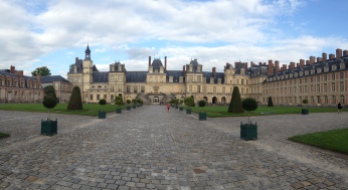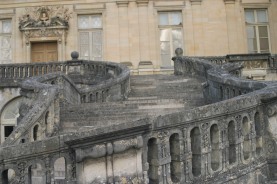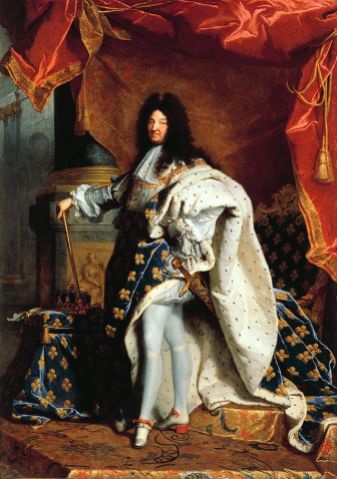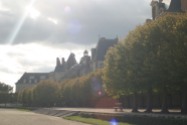Di tesori artistici noi italiani siamo pieni e ne siamo forse non troppo consapevoli, ma girando per l’Europa non restiamo certo indifferenti alle ricchezze che questo nostro vecchio continente custodisce amorevolmente. Una di queste è il Castello ddi Fontainebleau.
Dal latino Fons Bellaquaeus deriva Fontaine Belle Eau o Fontaine Belleau, fontana dalla bell’acqua, contratta poi in Fontainebleau. All’inizio fu un ritrovo di caccia e per più di sette secoli, da Luigi VI (1081-1137) a Napoleone III (1808-1873), numerosi sovrani vi hanno soggiornato per la bellezza della foresta circostante e la tranquillità che ci si poteva trovare così vicino a Parigi.
Il 18 ottobre 1685 Luigi XIV vi firmò il famoso Editto di Fontainebleau, che costituiva la revoca dell’Editto di Nantes, costringendo così all’esilio molti protestanti. Nel 1725 vi si tenne il matrimonio di Luigi XV. Il 29 ottobre 1807 Manuel Godoy, allora cancelliere del re spagnolo Carlo IV e Napoleone I vi firmarono il trattato che autorizzava il passaggio delle truppe francesi in terra di Spagna dirette in Portogallo. Lo stesso imperatore vi firmò l’atto di abdicazione nel 1814.
Nel 1848 la foresta di Fontainebleau fu dichiarata, sotto pressione popolare, “riserva artistica”, per difenderla dalla minaccia di un dissennato disboscamento. Lo scopo era quello di permettere agli artisti della scuola di Barbizon di ritrarre gli incantati paesaggi naturali che essa offriva ai pittori. Fu questo il primo provvedimento pubblico di tutela della natura della storia, anche se promosso e realizzato con finalità estetiche e non naturalistiche. Proprio per questo primato, cento anni dopo (1948), fu deciso di fondare l’Unione Internazionale per la Conservazione della Natura (IUCN) proprio nella città di Fontainebleau. Dal 1981 il castello ed il suo enorme parco sono iscritti alla lista del Patrimonio dell’umanità UNESCO.
Il manierismo francese degli interni del XVI secolo è noto con il termine di “stile Fontainebleau”: combina scultura, lavori in ferro battuto, pittura, stucco ed intarsi, mentre per gli esterni introdusse i giardini parterre. Grazie alle incisioni della “Scuola di Fontainebleau” questo nuovo stile venne esportato negli stati dell’Europa centro-settentrionale, soprattutto ad Anversa ed in Germania, per poi raggiungere anche Londra.
Ha 1500 ambienti interni, quasi 1900 tra finestre e porte-finestre, 116 ettari di giardini.
Il vecchio castello presente su questo sito era già usato alla fine del XII secolo da re Luigi VII, per conto del quale san Tommaso Becket consacrò la cappella. Fontainebleau era una delle residenze preferite da Filippo Augusto e da Luigi IX. Il creatore dell’attuale costruzione fu Francesco I. Il re invitò in Francia anche l’architetto Sebastiano Serlio e Leonardo da Vinci. La galleria di Francesco I, con i suoi affreschi incorniciati in stucco da Rosso Fiorentino, venne creata tra il 1532 ed il 1539, e rappresentava la prima grande galleria decorata della Francia. Il Rinascimento arrivò in Francia passando per Fontainebleau.
La Salle des Fêtes, durante il regno di Enrico II, venne decorata da pittori manieristi italiani, Francesco Primaticcio e Nicolò dell’Abate. La Ninfa di Fontainbleau di Benvenuto Cellini, commissionata per il castello, si trova oggi presso il museo del Louvre.
Enrico IV fece passare in mezzo al parco un canale da 1200 metri (tuttora pescoso) ed ordinò di piantare pini, olmi e piante da frutto. Il parco copre 80 ettari, è cintato da mura e costellato da sentieri rettilinei. Tre secoli dopo il castello cadde in disuso; durante la rivoluzione francese molti arredi originali vennero venduti, così come i contenuti di molti altri castelli reali, nel tentativo di recuperare soldi per lo Stato, e di evitare il futuro ritorno dei Borbone.
Nonostante questo l’imperatore Napoleone Bonaparte iniziò a trasformare il castello di Fontainebleau nel simbolo della sua grandezza, quale alternativa a quello vuoto di Versailles. A Fontainebleau Napoleone congedò la Vecchia Guardia andando in esilio nel 1814. Al piano terra è ben conservato il campo di Pallacorda (antenato del tennis) di Enrico IV. È il più grande campo al mondo di pallacorda, ed anche uno dei pochi di proprietà pubblica.
Tutto questo è nascosto solo ad una manciata di chilometri da Parigi e aspetta solo di essere riscoperto…
Le Château de Fontainebleau, parterre de Rois
We Italians are full of artistic treasure and we’re probably not too aware of it, but traveling around Europe we are certainly not indifferent to the riches that our old continent holds lovingly. One of these is the Castle of Fontainebleau.
Fons is derived from the Latin Bellaquaeus Fontaine Fontaine Belle Eau or Belleau, from the first water fountain, then contracted in Fontainebleau. At first it was a meeting place for hunting and for more than seven centuries, from Louis VI (1081-1137) to Napoleon III (1808-1873), numerous sovereigns have stayed there for the beauty of the surrounding forest and quiet so close to Paris.
On October 18, 1685 Louis XIV signed the Edict of you Fontainebleau, which was the revocation of the Edict of Nantes, forcing many Protestants into exile. In 1725 there was held the marriage of Louis XV. On October 29, 1807 Manuel Godoy, then chancellor of the Spanish king Charles IV and Napoleon I there signed the treaty which allowed the passage of the French troops in the land of Spain directly in Portugal. The same empero signed the act of abdication in 1814.
In 1848 the forest of Fontainebleau was declared, under popular pressure, “artistic reserve”, to defend against the threat of a reckless deforestation. The aim was to allow artists of the Barbizon school of portraying the enchanting natural landscapes that it offered to painters. This was the first public measure of protection of the nature of history, even if promoted and made with aesthetic purposes and not natural. Precisely for this record, a hundred years later (1948), it was decided to establish the International Union for Conservation of Nature (IUCN) right in the city of Fontainebleau. Since 1981, the castle and its huge park are enrolled in the list of humanity heritage by UNESCO.
The French Mannerist interior of the sixteenth century is known by the term “Fontainebleau style”: combines sculpture, iron works, painting, stucco and inlays, and the parterre gardens. Thanks to the engravings of the “School of Fontainebleau” this new style was exported in the states of central and northern Italy, especially in Antwerp and Germany, then to reach London.
It has 1500 interior, nearly 1900 windows and doors.
The old castle on this site was already used in the late twelfth century by King Louis VII, on behalf of whom Thomas Becket consecrated the chapel. Fontainebleau was a favorite residence of Philip Augustus and Louis IX. The creator of the construction was Francis I. The King invited in France the architect Sebastiano Serlio and Leonardo da Vinci. The gallery of Francis I, with its frescoes framed in stucco by Rosso Fiorentino, was created between 1532 and 1539, and represented the first great decorated gallery of France. The Renaissance arrived in France via Fontainebleau.
The Salle des Fêtes, in the reign of Henry II, was decorated by Italian Mannerist painters, Francesco Primaticcio and Nicolo dell’Abate. The Nymph of Fontainebleau of Benvenuto Cellini, which was commissioned for the castle, is now at the Louvre museum.
Henry IV built in the middle of the park a channel of 1,200 meters (still fishy) and ordered to plant pines, elms and fruit trees. The park covers 80 acres, is enclosed by walls and dotted paths straight. Three centuries later, the castle fell into disuse; during the French Revolution many original furnishings were sold, as well as the content of many other royal castles in an attempt to recover money for the state, and to prevent the future return of the Bourbons.
Despite this, the Emperor Napoleon Bonaparte began to transform the Château de Fontainebleau into a symbol of his grandeur, as an alternative to empty Versailles. At Fontainebleau Napoleon dismissed the Old Guard going into exile in 1814. In to the ground floor is well preserved the Pallacorda field (ancestor of tennis) of Henry IV. It is the largest field in the world of this kind, and also one of the few publicly owned.
All this is hidden only a few kilometers from Paris and it is just waiting to be rediscovered …
















































